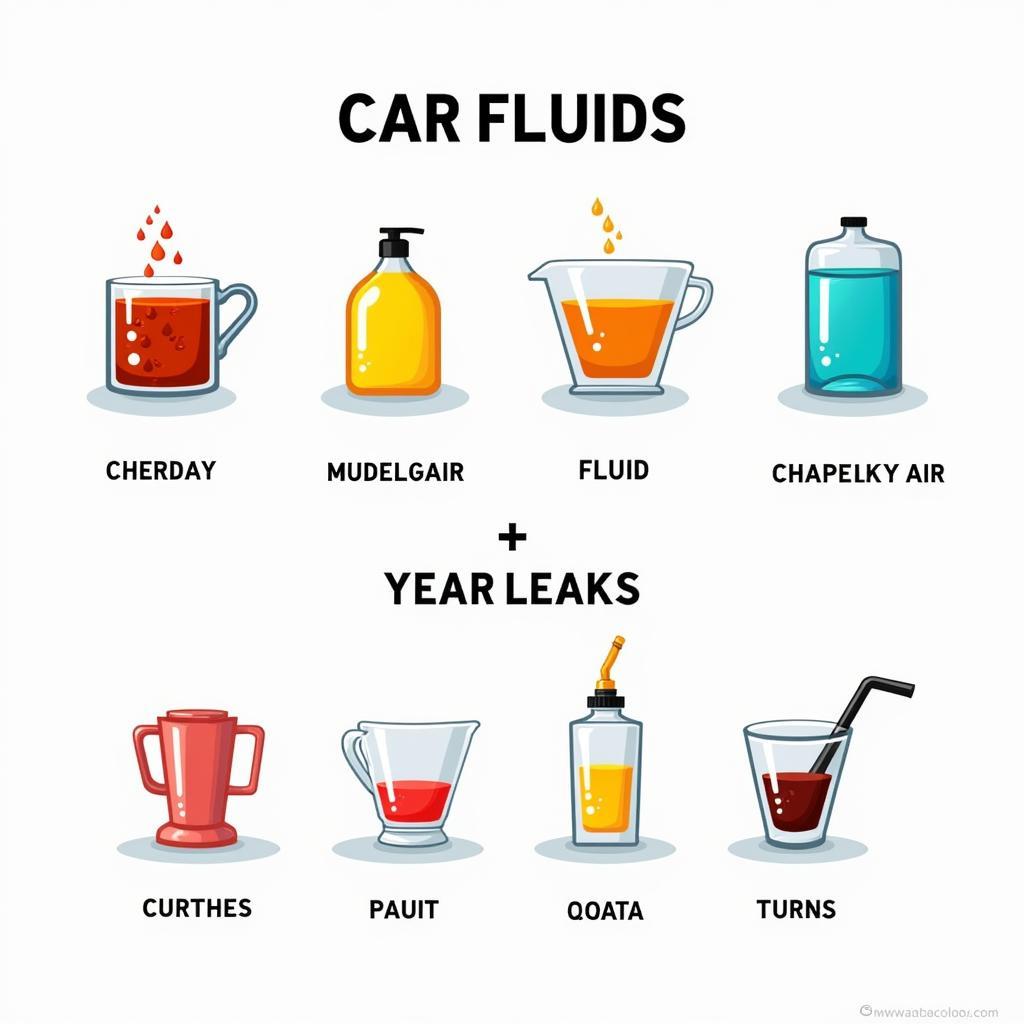Dealing with a car leak can be frustrating and messy. Identifying the source of the leak is the first step to fixing it. This comprehensive guide will walk you through the different types of car leaks, how to diagnose them, and the steps to take to fix them.
 Car Fluid Leak Types
Car Fluid Leak Types
Common Types of Car Leaks
Before you can fix a leak, you need to know what’s leaking. Cars utilize various fluids, each with a unique color and consistency. Here’s a quick rundown:
- Coolant: Usually green or orange, a sweet smell, and a slippery feel.
- Oil: Brown or black, with a thick consistency and a strong petroleum odor.
- Brake Fluid: Clear or yellowish, with a consistency similar to cooking oil.
- Transmission Fluid: Red or brown, with a sweet smell and a slightly thicker consistency than oil.
- Power Steering Fluid: Reddish-brown when new, turning darker with age.
- Water: Usually a clear puddle with no particular smell. This could indicate a problem with your car’s AC system or a simple case of condensation.
Diagnosing the Leak
 Locating a Car Leak in a Garage
Locating a Car Leak in a Garage
Once you have a general idea of what’s leaking, pinpointing the location is crucial.
- Park on a clean, dry surface: This could be your driveway or garage floor. A light-colored surface will make it easier to see the color of the fluid.
- Place cardboard or paper under your car: This will help collect any drips and make it easier to see the color and location.
- Inspect the cardboard after a few hours: The location of the fluid on the cardboard can give you a general idea of where the leak is coming from.
- Check fluid levels: Regularly check your car’s fluid levels (oil, coolant, brake fluid, power steering fluid, transmission fluid). A consistently low fluid level is a clear indicator of a leak.
Fixing the Leak
The repair process for a car leak varies greatly depending on the fluid and the source of the leak. Here are some general steps:
- Simple Fixes: Sometimes, a leak can be as simple as a loose cap or a cracked hose. Tightening a cap or replacing a hose is a relatively easy DIY fix.
- Patching Small Leaks: For small leaks in certain components, you can find leak-stopping additives or sealants at your local auto parts store. While these are temporary fixes, they can buy you time until you can have the problem properly repaired.
- Professional Repair: For more complex leaks or if you’re uncomfortable working on your car yourself, it’s always best to consult a professional mechanic. They have the tools, knowledge, and expertise to diagnose and fix the leak correctly.
Preventing Future Leaks
Prevention is always better than cure. Here are a few tips to help prevent future car leaks:
- Regular Maintenance: Regular oil changes, fluid top-ups, and inspections can help catch leaks early on.
- Inspect Your Belts and Hoses: Cracked or worn belts and hoses are a common cause of leaks.
- Don’t Overfill Fluids: Overfilling can lead to pressure buildup and leaks. Always refer to your owner’s manual for the correct fluid levels.
When to Seek Professional Help
 Car Mechanic Inspecting a Leak
Car Mechanic Inspecting a Leak
While some car leaks can be simple DIY fixes, others require professional expertise. If you notice any of the following, it’s best to contact a mechanic immediately:
- Leaks you can’t identify
- Leaking brake fluid
- Large puddles of fluid
- Leaks accompanied by warning lights on your dashboard
Addressing car leaks promptly not only saves you from the hassle of dealing with a messy car but also prevents potential damage to your car’s engine and other vital components.
Have you ever had to deal with a chipped windshield? Find out how much is to fix a dent in a car and avoid unexpected costs.
Fix Car Leak: FAQs
1. Can I drive with a car leak?
Driving with a leak is not recommended, especially if it’s a fluid vital to your car’s operation, like brake fluid.
2. How much does it cost to fix a car leak?
The cost of repair depends on the type of fluid, the severity of the leak, and the labor costs in your area.
3. How do I know if my car is leaking coolant or water?
Coolant is usually green or orange and has a sweet smell, while water is clear and odorless.
4. Can I fix a power steering fluid leak myself?
While replacing a power steering hose might be a DIY fix, it’s best to consult a mechanic for anything beyond that.
5. How often should I check my car fluids?
It’s a good habit to check your car fluids at least once a month.
Fixing chipped and scratched car paint can be a DIY project. Learn more about fixing chipped and scratched car paing.
Don’t let a car leak become a major problem. By understanding the basics of car leaks, you can address the issue promptly and keep your car running smoothly. If you need assistance, don’t hesitate to contact the experts at AutoTipPro at +1 (641) 206-8880. We’re located at 500 N St Mary’s St, San Antonio, TX 78205, United States.





Leave a Reply